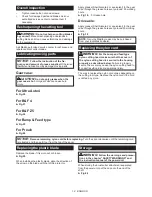
17
ENGLISH
Installing plastic blade
Optional accessory
CAUTION:
If the plastic blade accidentally
impacts a rock or hard object during operation,
stop the tool and inspect for any damage. If the
plastic blade is damaged, replace it immediately.
Use of a damaged cutting tool could result in serious
personal injury.
CAUTION:
Be sure to remove the hex
wrench after installation.
NOTICE:
Be sure to use genuine Makita plastic
blade.
►
Fig.12:
1.
Plastic blade
2.
Receive washer
3.
Shaft
4.
Hex wrench
5.
Tighten
1.
Put the receive washer on the shaft.
2.
Insert the hex wrench through the hole on the gear
case and rotate the spindle until the spindle is locked.
3.
Place the plastic blade onto the threaded spindle
directly and tighten.
4.
Remove the hex wrench.
To remove the plastic blade, turn it clockwise while hold-
ing the receive washer with the hex wrench.
Mounting the attachment pipe
CAUTION:
Always check that the attach-
ment pipe is secured after installation.
Improper
installation may cause the attachment falling off from
the power unit and cause personal injury.
Mount the attachment pipe to the power unit.
1.
Turn the lever toward the attachment.
►
Fig.13:
1.
Lever
2.
Align the pin with the arrow mark and insert the
attachment pipe until the release button pops up.
►
Fig.14:
1.
Release button
2.
Arrow mark
3.
Pin
3.
Turn the lever toward the power unit.
►
Fig.15:
1.
Lever
Make sure that the surface of the lever is parallel to the
pipe.
To remove the pipe, turn the lever toward the attach-
ment and pull the pipe out while pressing down the
release button.
►
Fig.16:
1.
Release button
2.
Lever
3.
Pipe
OPERATION
WARNING:
Follow the warnings and precau-
tions in the chapter “SAFETY WARNINGS” and
the instruction manual of the power unit.
WARNING:
If the cutting tool moves at
idle, adjust the idle speed of the engine down.
Otherwise you cannot stop the cutting tool by throttle
off and it may cause serious injury.
Adjusting the hanger position and
shoulder harness
WARNING:
Do not use the tool if you cannot
adjust the hanger position and shoulder harness
length within the range as illustrated.
Using the
tool with improper weight balance may bring the
cutting tool upward and result in personal injury.
When replacing an accessory with another, the weight
balance of the equipment may change. In such case,
adjust the hanger position and shoulder harness length
as follows.
►
Fig.17:
1.
Hanger
To change the hanger position, loosen the fixing screw
on the hanger and then move the hanger (A).
Adjust the hanger position and shoulder harness length
so that:
•
the hanger positions 750 mm or higher from the
ground,
•
the cutting tool positions 100 mm to 300 mm high
from the ground and,
•
the unguarded part of cutting tool is horizontally
750 mm or further away from the hanger.
After adjusting the hanger position, tighten the screw
with a wrench or screwdriver (depending on the power
unit) securely.
Using a nylon cutting head
During operation, use the tip of the nylon cutting cord
for cut. As the nylon cutting cord is worn and shortened
with the cutting operation, the operator needs to feed it
manually. To feed the nylon cutting cord, tap the nylon
cutting head on the ground while it rotates around 6,000
min
-1
.
NOTE:
If the nylon cutting cord does not feed out,
rewind it. Refer to the chapter “MAINTENANCE.”
MAINTENANCE
WARNING:
Before inspecting or maintaining
the equipment, switch off the motor and remove
the spark plug cap or battery cartridge.
Otherwise
the cutting tool or other parts may move and result in
serious injury.
WARNING:
When inspecting or maintaining
the equipment, always put it down.
Assembling or
adjusting the equipment in an upright position may
result in serious injury.
WARNING:
Follow the warnings and precau-
tions in the chapter “SAFETY WARNINGS” and
the instruction manual of the power unit.
NOTICE:
Never use gasoline, benzine, thinner,
alcohol or the like. Discoloration, deformation or
cracks may result.
Summary of Contents for EM404MP
Page 4: ...Fig 12 3 1 2 Fig 16 1 750 mm 750 mm 100 300 mm Fig 17 1 Fig 18 Fig 19 4 ...
Page 5: ...3 m 80 mm 100 mm 䍺2 7 mm 䍺2 4 mm Fig 20 5 ...
Page 6: ...3 m 80 mm 100 mm 䍺2 7 mm 䍺2 4 mm Fig 21 6 ...
Page 7: ...3 m 80 mm 100 mm 䍺2 7 mm 䍺2 4 mm Fig 22 7 ...
Page 8: ...3 m 80 mm 100 mm 䍺2 7 mm 䍺2 4 mm Fig 23 8 ...
Page 9: ...4 5 m 100 mm 2 4 mm 2 4 mm Fig 24 9 ...
Page 10: ...Fig 25 Fig 26 10 ...



































